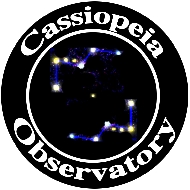Visitors (human kind), iPhone Moon Imaging
Posted: 29 November 2015
|
Open: Saturday, 28 November 2015, 1703 MST Temperature: 63°F |
Session: 889 Conditions: Clear |
I opened the observatory a little early to prepare for the arrival of some visitors. I set up two chairs on the observatory patio. 1711 MST: slewed the telescope to the star Fomalhaut and set the focus for 83X. 1718 MST: sunset. The Greene family arrived at 1732 MST. I gave them a site overview and a brief talk about the SkyShed POD observatory. Here they are in front of Cassiopeia Observatory:

The above photo was taken with a Nikon D7200 DSLR and flash. This next photo, taken with the handheld D7200 at 1804 MST, f/3.5, 1/2sec, ISO 6400, and without the flash, shows a more realistic view of the scene 46 minutes after sunset:

We began observing about 1810 MST using the Meade 8" LX200-ACF telescope. First viewed were the planets Neptune and Uranus at a magnification of 222X. Next, I pointed out the Andromeda Galaxy high in the sky and let them see it with their naked eyes. I then added a focal reducer to the telescope for our initial Deep Sky Object (DSO) viewing and we observed the Andromeda Galaxy (Messier 31) and its companion galaxies M32 and M110. With the magnification at 53X all three galaxies were seen in the field-of-view (FOV) of the eyepiece. The telescope was then slewed to the Double Cluster (open star clusters) and both clusters were seen in the eyepiece FOV. We then observed the Pleiades (M45, "the seven sisters") at 53X. The time for their stay at the observatory was running out by now. I removed the focal reducer from the telescope and we viewed the Great Globular Cluster in Hercules (M13) at a magnification of 83X. This DSO was very low in the western sky and was not a great view through the tree branches. The final DSO viewed was the Ring Nebula (M57) in the constellation of Lyra using 83X. Throughout most of their time at the observatory we saw many Earth-orbiting satellites, most in polar orbits. Several even "flared" brightly in the reflected sunlight. The family really enjoyed their visit to Cassiopeia Observatory. They left at 1935 MST.
2000 MST: the eastern sky was beginning to brighten due to the soon-to-rise waning gibbous Moon. I took a quick look at the Crab Nebula (M1), 83X.
2017-2032 MST: took a short break. When I returned to the observatory I took some quick looks at the Pleiades (M45), the Double Cluster, and the Andromeda Galaxy using the Celestron Cometron 12x70 binoculars. Nice views.
2039 MST: slewed the telescope to the Moon, which was about to rise over the hill to the East. 2104-2106 MST: watched the waning gibbous Moon rise over the hill using 83X. Fun view.
I then set up to photograph the Moon being projected onto the observatory dome with the Apple iPhone 6s Plus and the low-light app "NightCap Pro". I have previously photographed the "Moon on Dome" using a DSLR, as seen on my Observatory Photo Album, but I was curious if the iPhone could do it. I attached the iPhone to the GorillaPod and placed it on the POD Roller Desk. I set NightCap Pro for Long Exposure, Light Boost, ISO 8000, 1/3sec, and did a 60 second exposure using the Earbuds/Mic volume control as a remote shutter release. While obviously not as good as the DSLR photos, the iPhone was able to capture the telescope with the Moon projected on the observatory dome:

I then took this handheld iPhone photo of the Moon using the iOS Camera app, afocal 83X (2" Meade 24mm UWA eyepiece). The Moon was still very low in the eastern sky so the seeing was not very good.

I then mounted the iPhone 6s Plus on a 1.25" Meade 26mm eyepiece (77X) using the Orion SteadyPix Universal Smartphone Telescope Photo Mount for this photo:

I added a Televue 2X PowerMate for these iPhone afocal 154X photos of the northern and southern terminator regions:


2132 MST: ended imaging. Took a quick look at the Moon, 154X, and a final look at the Moon, 83X.
|
Close: Saturday, 28 November 2015, 2145 MST Temperature: 37°F |
Session Length: 4h 42m Conditions: Clear |
I have rearranged the Comets, Star Clusters, Nebulae, and Galaxies Astrophotography Photo Albums to have separate pages for each year 2010-2015. I hope this is easier to use.
Comments are welcome using Email. If you are on Twitter you can use the button below to tweet this report to your followers. Thanks.
Cassiopeia Observatory Home Page
Copyright ©2015 Michael L. Weasner / mweasner@me.com
URL = http://www.weasner.com/co/Reports/2015/11/29/index.html

